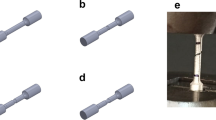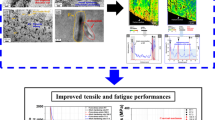The aim of this paper is to develop a set of creep aging constitutive equations for Al–Cu–Mg alloys containing plate- or rod-like precipitates. Average length, aspect ratio and relative volume fraction are introduced to quantitatively analyze the effect of the precipitates of such alloy on creep aging process. The strong interaction between creep deformation and aging treatment is considered by the intermediate state variables of dislocation density and precipitate characteristic dimension. A unified creep aging constitutive equation is derived, in which the correlations between microscopic characteristics and macroperformances of material are linked by the yield strength of the material. Using AA2124 alloy, a series of uniaxial tensile creep tests are carried out at 185°C for 12 h with different stresses. The material constants within constitutive models are determined from the experimental data. A good agreement between experimental and computed values confirms that the established constitutive equations can well characterize the creep behavior.






Similar content being viewed by others
References
N. Zarei-Hanzaki A. and H. R. Abedi, “The flow behavior modeling of cast A356 aluminum alloy at elevated temperatures considering the effect of strain,” Mater. Sci. Eng. A, 535, 252–257 (2012).
A. W. Zhu, J. Chen, and E. A. Starke, “Precipitation strengthening of stress-aged Al-xCu alloys,” Acta Mater., 48, 2239–2246 (2000).
Y. Tian, L. Huang, H. J. Ma, and J. J. Li, “Establishment and comparison of four constitutive models of 5A02 aluminium alloy in high-velocity forming process,” Mater. Des., 54, 587–597 (2014).
X. Tang, V. Prakash, J. J. Lewandowski, et al., “Inertial stabilization of buckling at high rates of loading and low test temperatures: Implications for dynamic crush resistance of aluminum-alloy-based sandwich plates with lattice core,” Acta Mater., 55, 2829–2840 (2007).
X. Tang, D. Li , V. Prakash, and J. J. Lewandowski, “Effects of microstructure on high strain rate deformation and flow behaviour of Al–Mg–Si alloy (AA6061) under uniaxial compression and combined compression and shear loading,” Mater. Sci. Technol., 27, 13–20 (2011).
H. N. G. Wadley, K. P. Dharmasena, M. R. O’Masta, and J. J. Wetzel, “Impact response of aluminum corrugated core sandwich panels,” Int. J. Impact Eng., 62, 114–128 (2013).
J. G. Liu, S. Pattofatto, D. N. Fang, et al., “Impact strength enhancement of aluminum tetrahedral lattice truss core structures,” Int. J. Impact Eng., 79, 3–13 (2015).
M. T. Ma, J. H. You, H. Z. Lu, and Z. W. Wang, “Research progress of aluminum alloy automotive sheet and application technology,” Eng. Sci., 12, 4–20 (2010).
M. A. Hamstad, R. Bianchetti, and A. K. Mukherjee, “A correlation between acoustic emission and the fracture toughness of 2124-T851 aluminum,” Eng. Fract. Mech., 9, 663–674 (1977).
Y. B. Liu, Z. Y. Liu, Y. T. Li, et al., “Enhanced fatigue crack propagation resistance of an Al-Cu-Mg alloy by artificial aging,” Mater. Sci. Eng. A, 492, 333–336 (2008).
N. Kamp, N. Gao, M. J. Starink, and I. Sinclair, “Influence of grain structure and slip planarity on fatigue crack growth in low alloying artificially aged 2xxx aluminium alloys,” Int. J. Fatigue, 29, 869–878 (2007).
M. Sallah, J. Peddieson, Jr., and S. A. Foroudastan, “Mathematical model of autoclave age forming,” J. Mater. Process. Technol., 28, 211–219 (1991).
Z. L. Kowalewski, D. R. Hayhurst, and B. F. Dyson, “Mechanisms-based creep constitutive equations for an aluminium alloy,” J. Strain Anal. Eng. Des., 29, 309–316 (1994).
K. C. Ho, J. Lin, and T. A. Dean, “Constitutive modelling of primary creep for age forming an aluminium alloy,” J. Mater. Process. Technol., 153, 122–127 (2004).
L. H. Zhan, J. G. Lin, T. A. Dean, and M. H. Huang, “Experimental studies and constitutive modelling of the hardening of aluminium alloy 7055 under creep age forming conditions,” Int. J. Mech. Sci., 53, 595–605 (2011).
C. Li, M. Wan, X. Wu, and L. Huang, “Constitutive equations in creep of 7B04 aluminum alloys,” Mater. Sci. Eng. A, 527, 3623–3629 (2010).
J. Zhang, Y. L. Deng, and X. M. Zhang, “Constitutive modeling for creep age forming of heat-treatable strengthening aluminum alloys containing plate or rod shaped precipitates,” Mater. Sci. Eng. A, 563, 8–15 (2013).
X. Q. Zhao, M. J. Shi, J. H. Chen, et al., “A facile electron microscopy method for measuring precipitate volume fractions in AlCuMg alloys,” Mater. Charact., 69, 31–36 (2012).
G. Liu, X. D. Ding, J. Sun, and K. H. Chen, “A model for age strengthening of plate-like-precipitatecontaining Al alloys,” Chin. J. Nonferrous Met., 11, 337–347 (2001).
Y. G. Li, Experimental Study and Constitutive Modeling on Creep Aging for 2124 Aluminum Alloy, Central South University, Changsha (2012).
S. M. Kumaran, “Evaluation of precipitation reaction in 2024 Al-Cu alloy through ultrasonic parameters,” Mater. Sci. Eng. A, 528, 4152–4158 (2011).
C. Badini, F. Marino, and E. Verne, “Calorimetric study on precipitation path in 2024 alloy and its SiC composite,” Mater. Sci. Eng. A, 191, 185–191 (1995).
A. W. Zhu and E. A. Starke, “Stress aging of Al-Cu alloys: computer modeling,” Acta Mater., 49, 3063–3069 (2001).
D. Q. Chen, Z. Q. Zhen, S. C. Li, et al., “Effect of external stress on the growth of precipitates in Al-Cu and Al-Cu-Mg-Ag alloys,” Acta Metall., 40, 799–804 (2004).
A. W. Zhu and E. A. Starke, “Strengthening effect of unshearable particles of finite size: A computer experimental study,” Acta Mater., 47, 3263–3269 (1999).
F. Barlat, M. V. Glazov, J. C. Brem, and D. J. Lege, “A simple model for dislocation behavior, strain and strain rate hardening evolution in deforming aluminum alloys,” Int. J. Plast., 18, 919–939 (2002).
J. D. Teixeira, D. G. Cram, L. Bourgeois, et al., “On the strengthening response of aluminum alloys containing shear-resistant plate-shaped precipitates,” Acta Mater., 56, 6109–6122 (2008).
H. R. Shercliff and M. F. Ashby, “A process model for age hardening of aluminium alloys – I. The model,” Acta Metall. Mater., 38, 1789–1802 (1990).
G. Liu, J. Sun, C. W. Nan, and K. H. Chen, “Experiment and multiscale modeling of the coupled influence of constituents and precipitates on the ductile fracture of heat-treatable aluminum alloys,” Acta Mater., 53, 3459–3468 (2005).
G. Liu, G. J. Zhang, X. D. Ding, et al., “Modeling the strengthening response to aging process of heat-treatable aluminum alloys containing plate/disc- or rod/needle-shaped precipitates,” Mater. Sci. Eng. A, 344, 113–124 (2003).
Acknowledgments. This research was supported by the National Basic Research Program of China (Grant No. 2014CB046602), the Key Program of National Natural Science Foundation of China (Grant No. 51235010), and Ph.D. Programs Foundation of Ministry of Education of China (Grant No. 20120162110003).
Author information
Authors and Affiliations
Additional information
Translated from Problemy Prochnosti, No. 1, pp. 29 – 38, January – February, 2016.
Rights and permissions
About this article
Cite this article
Yang, Y.L., Zhan, L.H. & Xu, X.L. Constitutive Modeling for Al–Cu–Mg Alloy in Creep Aging Process. Strength Mater 48, 23–31 (2016). https://doi.org/10.1007/s11223-016-9733-8
Received:
Published:
Issue Date:
DOI: https://doi.org/10.1007/s11223-016-9733-8




